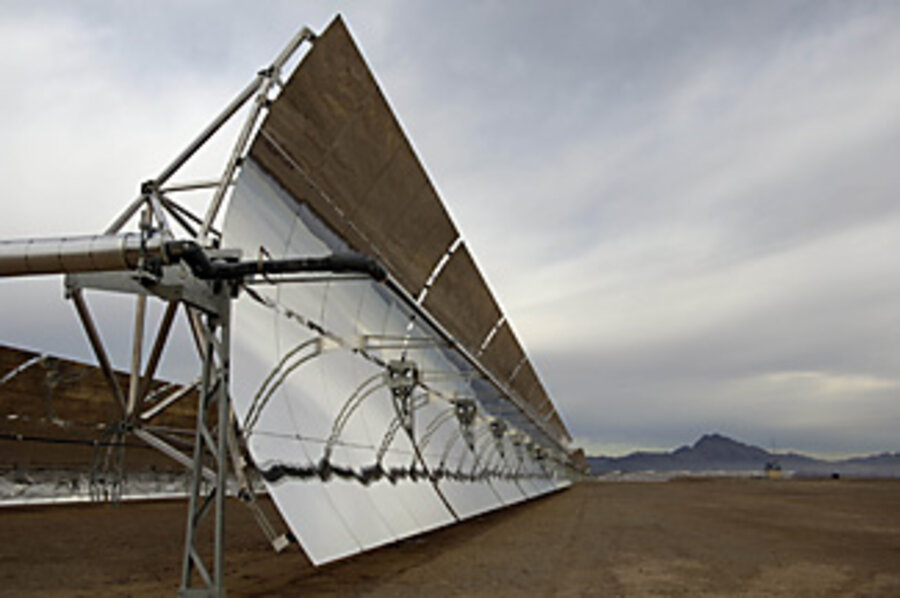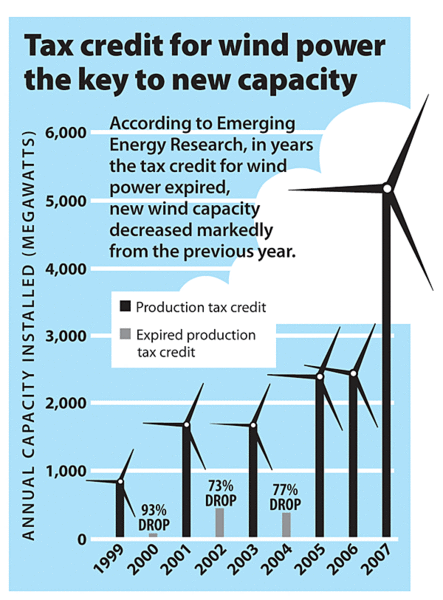Wind, solar tax credits to expire
| BOSTON
With a big new solar power plant in the Nevada desert and thousands of wind turbines sprouting nationwide, US renewable energy seems poised for a boom as long as federal tax credits don't suddenly evaporate.
After years of start-and-stop growth, wind-and solar- power industries soared in 2007, thanks to three consecutive years of tax credits that provided a critical lift for both sectors.
But whether the fledgling industries can fly without tax credits, due to expire at the end of this year, is a question being debated on Capitol Hill this week.
As demand grows for a stimulus package for the faltering US economy, green-energy advocates argue that wind and solar – both left out of the new energy law passed last month – should be part of the package.
"The wind and solar investment project decisions made in this quarter will be halted without these critical tax credits," says Anna Aurilio, federal legislative director for US Public Interest Research Group in Washington. "It would be a tragedy to bypass industries that are going to meet US energy needs and create jobs."
The 2005 energy bill provided exactly the kind of multiyear support the wind industry says it needs. The impact has been dramatic. Nearly one-third of all US power capacity added last year – about 5,244 megawatts – was in wind. Overall wind-generating capacity soared 45 percent last year, adding the clean-energy equivalent of 10 large coal-fired power plants, the American Wind Energy Association (AWEA) reported last week.
Wind power injected $9 billion into the US economy and now employs 20,000 people directly, the industry says. Plans for at least eight new US wind-power manufacturing plants employing 5,000 workers were announced last year, AWEA officials say.
"This is a critical time for extending the production tax credit for wind," says Joshua Magee, research director for wind energy at Emerging Energy Research, a Boston-based research firm. "If we move into 2009 and it hasn't been extended, new orders will shrink and it will be a major blow to these new US [wind] manufacturing, investment, and jobs across many states."
Last year solar power, though far smaller than wind, grew 43 percent, adding 110 megawatts of new capacity. At least eight large solar-power projects – with capacity equal to six large 500-megawatt coal-fired plants – are now in the development pipeline. Manufacturing and jobs are part of the solar picture, too.
With such growth in view, Schott AG of Mainz, Germany, last week announced plans to spend $100 million to build a new solar-part production factory near Albuquerque, N.M. It will initially employ 350 workers.
If the US market expands, the new Schott factory could expand to employ as many as 1,500 people. But if tax incentives aren't extended for several more years, the number of jobs would probably be far smaller, company officials say.
"The tax credits definitely set a positive environment for manufacturers like us to make long-term investments," says Mark Finocchario, president of Schott Solar, the US subsidiary headquartered in Roseville, Calif.
A one-year extension would help, he says. But it's the proposal for an eight-year extension that would be a long-term stimulus for jobs and investment.
The production tax credit, or PTC, now pays utilities about 2 cents for every kilowatt of wind power they produce over the first 10 years of a project's operation. Congress's Joint Committee on Taxation estimated the cost to taxpayers at less than $1 billion a year, AWEA officials say.
The solar investment tax credit, or ITC, if extended for eight years would raise a cap on the tax credit for residential installations from $2,000 to $4,000, and would allow utilities to tap the credit, too. Total cost: about $800 million.
Together, today's tax breaks for wind and solar cost taxpayers a little more than $1 billion annually.
Where to get the money to pay for the renewed tax credits for solar and wind power has been difficult. Efforts to wrap them into the new energy law foundered last month, in the face of opposition from the White House and GOP senators.
In a press conference expected Tuesday, environmental groups will push for the credits to be included in the new stimulus package. If that fails, hope remains that the farm bill or some other bill may rescue wind and solar before the year ends.
"This is good public policy that will produce jobs and help the economy," says Randall Swisher, AWEA executive director. "The question remains how Congress will get this done, but I think they will. I hope so."






